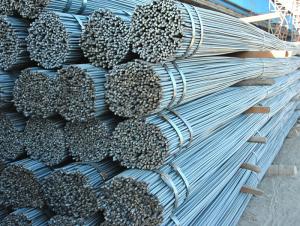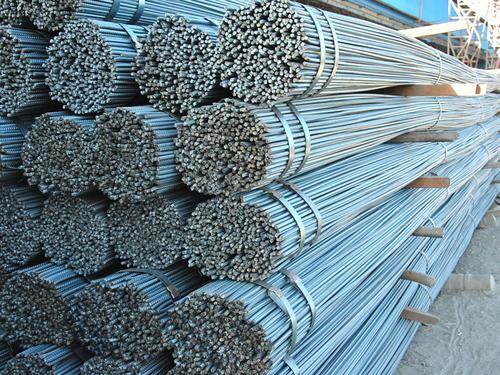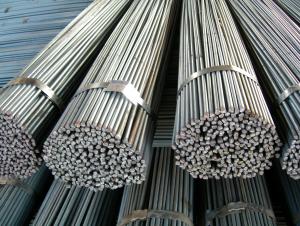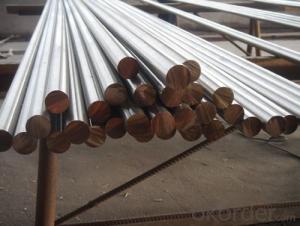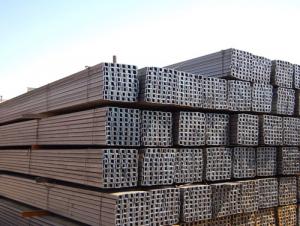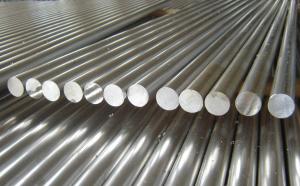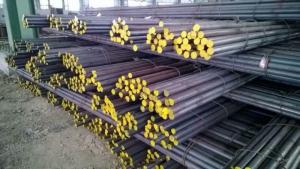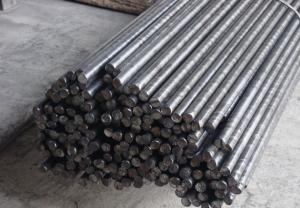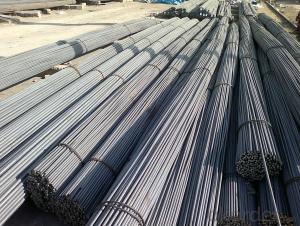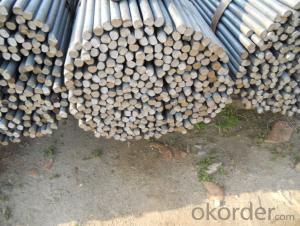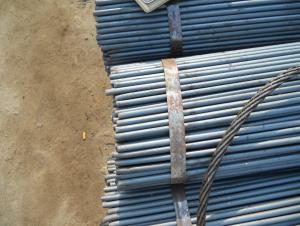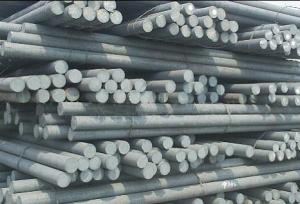Round Bar 5mm-100mm GBQ195 Q235 Hot Rolled High Quality
- Loading Port:
- China Main Port
- Payment Terms:
- TT or LC
- Min Order Qty:
- -
- Supply Capability:
- -
OKorder Service Pledge
OKorder Financial Service
You Might Also Like
Product Description:
OKorder is offering high quality Round Bar 5mm-100mm GBQ195 Q235 Hot Rolled at great prices with worldwide shipping. Our supplier is a world-class manufacturer of steel, with our products utilized the world over. OKorder annually supplies products to European, North American and Asian markets. We provide quotations within 24 hours of receiving an inquiry and guarantee competitive prices.
Product Applications:
Deformed bar is widely used in buildings, bridges, roads and other engineering construction. Big to highways, railways, bridges, culverts, tunnels, public facilities such as flood control, dam, small to housing construction, beam, column, wall and the foundation of the plate, deformed bar is an integral structure material. With the development of world economy and the vigorous development of infrastructure construction, real estate, the demand for deformed bar will be larger and larger
Product Advantages:
OKorder's Round Bar 5mm-100mm GBQ195 Q235 Hot Rolled High Quality are durable, strong, and resist corrosion, exact size, regular package, chemical and mechanical properties are stable.
Main Product Features:
· Premium quality
· Prompt delivery & seaworthy packing (30 days after receiving deposit)
· Corrosion resistance
· Can be recycled and reused
· Mill test certification
· Professional Service
· Competitive pricing
Product Specifications:
Manufacture: Hot rolled
Grade: BS4449
Certificates: ISO, SGS, BV, CIQ
Diameter: 6mm,8mm,10mm,12mm,14mm,16mm,18mm,20mm,
22mm,25mm,28mm,32mm,36mm,40mm,50mm
Length: 6M, 9M,12M or as required
Packaging: Export packing, nude packing, bundled
Chemical Composition: (Please kindly find our chemistry of our material based on HRB500 as below for your information)
Grade | Technical data of the original chemical composition (%) | ||||||
C | Mn | Si | S | P | V | ||
HRB400 | ≤0.25 | ≤1.60 | ≤0.80 | ≤0.045 | ≤0.045 | 0.04-0.12 | |
Physical capability | |||||||
Yield Strength (N/cm²) | Tensile Strength (N/cm²) | Elongation (%) | |||||
≥400 | ≥570 | ≥14 | |||||
Theoretical weight and section area of each diameter as below for your information:
Diameter(mm) | Section area (mm²) | Mass(kg/m) | Weight of 12m bar(kg) |
6 | 28.27 | 0.222 | 2.664 |
8 | 50.27 | 0.395 | 4.74 |
10 | 78.54 | 0.617 | 7.404 |
12 | 113.1 | 0.888 | 10.656 |
14 | 153.9 | 1.21 | 14.52 |
16 | 201.1 | 1.58 | 18.96 |
18 | 254.5 | 2.00 | 24 |
20 | 314.2 | 2.47 | 29.64 |
22 | 380.1 | 2.98 | 35.76 |
25 | 490.9 | 3.85 | 46.2 |
28 | 615.8 | 4.83 | 57.96 |
32 | 804.2 | 6.31 | 75.72 |
36 | 1018 | 7.99 | 98.88 |
40 | 1257 | 9.87 | 118.44 |
50 | 1964 | 15.42 | 185.04 |
FAQ:
Q1: How soon can we receive the product after purchase?
A1: Within three days of placing an order, we will begin production. The specific shipping date is dependent upon international and government factors, but is typically 7 to 10 workdays.
Q2: What makes stainless steel stainless?
A2: Stainless steel must contain at least 10.5 % chromium. It is this element that reacts with the oxygen in the air to form a complex chrome-oxide surface layer that is invisible but strong enough to prevent further oxygen from "staining" (rusting) the surface. Higher levels of chromium and the addition of other alloying elements such as nickel and molybdenum enhance this surface layer and improve the corrosion resistance of the stainless material.
Q3: Can stainless steel rust?
A3: Stainless does not "rust" as you think of regular steel rusting with a red oxide on the surface that flakes off. If you see red rust it is probably due to some iron particles that have contaminated the surface of the stainless steel and it is these iron particles that are rusting. Look at the source of the rusting and see if you can remove it from the surface.
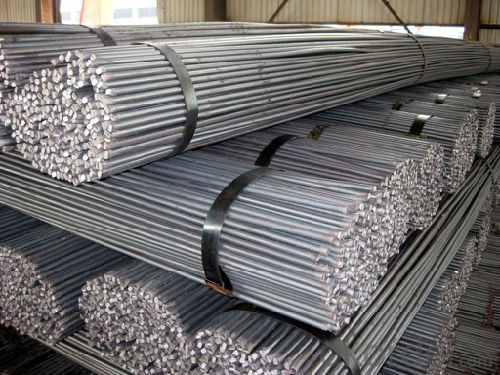
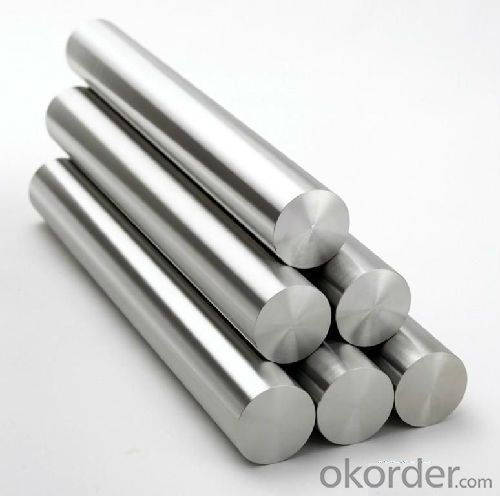
- Q: Is steel bar round wire? What's the difference? What are the main applications of wire rod?
- Round bar is divided into three parts: hot rolling, forging and cold drawing. Standard Specification for hot rolled round steel is 5.5-250 mm. Of them: 5.5-25 mm small round bars are mostly supplied by straight strips. They are used as reinforcing bars, bolts and various mechanical parts. They are more than 25 millimeters of round steel. They are mainly used in the manufacture of mechanical parts or seamless steel tube billets.
- Q: How do steel round bars compare to brass round bars?
- Steel round bars and brass round bars have several key differences that make them suitable for different applications. Firstly, steel round bars are much stronger and more durable compared to brass round bars. Steel has a higher tensile strength, making it ideal for applications that require high strength and resistance to heavy loads. It is commonly used in construction, manufacturing, and automotive industries where strength and durability are crucial. On the other hand, brass round bars are known for their excellent corrosion resistance and electrical conductivity. Brass is an alloy of copper and zinc, which gives it a unique combination of properties. It is often used in applications that require good electrical conductivity, such as electrical connectors, plumbing fittings, and musical instruments. Brass also has an attractive golden appearance, making it a popular choice for decorative purposes. In terms of cost, steel round bars are generally more affordable compared to brass round bars. Steel is widely available and produced in large quantities, resulting in a lower cost per unit. Brass, being an alloy of copper, which is a relatively expensive metal, is generally more expensive. Another important factor to consider is machinability. Steel round bars are generally easier to machine and work with compared to brass round bars. Steel has good cutting and drilling properties, making it easier to fabricate into various shapes and sizes. Brass, on the other hand, tends to have a higher machinability rating, meaning it is easier to cut and shape compared to other metals. In summary, steel round bars are stronger, more durable, and generally more affordable than brass round bars. They are suitable for applications that require high strength and resistance to heavy loads. Brass round bars, on the other hand, offer excellent corrosion resistance, electrical conductivity, and an attractive appearance. They are commonly used in applications that require good electrical conductivity and for decorative purposes. The choice between steel and brass round bars ultimately depends on the specific requirements of the application.
- Q: What is the maximum length available for steel round bars?
- The maximum length available for steel round bars can vary depending on the supplier and the specific requirements, but typically it can range from 12 to 24 feet.
- Q: What are the different types of steel round bar heat treatments?
- Steel round bars can undergo several types of heat treatments, each aiming to enhance specific material properties. Common heat treatments include annealing, normalizing, quenching and tempering, and case hardening. 1. Annealing involves heating the steel round bar to a high temperature and gradually cooling it to room temperature. This process relieves internal stresses, improves machinability, and enhances ductility and toughness. 2. Normalizing, similar to annealing, requires heating the steel round bar to a specific temperature. However, instead of slow cooling, the bar is left to cool in air. Normalizing refines the grain structure, improves mechanical properties, and enhances machinability. 3. Quenching and tempering entails heating the steel round bar to a high temperature and rapidly cooling it using a quenching medium like oil or water. This rapid cooling achieves high hardness and strength. Subsequently, the steel is tempered by reheating it to a lower temperature, enhancing toughness and reducing brittleness. 4. Case hardening is employed to increase the surface hardness of the steel round bar while maintaining a tough core. This treatment involves heating the bar in the presence of carbon-rich substances like gas or liquid carburizing agents. It results in a hardened outer layer, known as the case, while the core remains relatively softer and more ductile. These examples demonstrate the various heat treatments applicable to steel round bars. The choice of heat treatment depends on the desired properties and applications of the steel. Consulting with metallurgical experts ensures the selection of the most appropriate treatment for each specific steel round bar.
- Q: Can steel round bars be used in the manufacturing of springs?
- Yes, steel round bars can be used in the manufacturing of springs. Steel is a common material used in spring manufacturing due to its excellent properties such as high strength, durability, and flexibility. Steel round bars can be shaped and formed into the desired spring shape using various manufacturing processes like hot rolling, cold drawing, or machining. The specific type of steel round bar used will depend on the application and desired characteristics of the spring, such as the level of stiffness or resistance required. Overall, steel round bars are a widely used and reliable choice for the manufacturing of springs.
- Q: What are the different types of steel round bar surface finishes used in the construction industry?
- Steel round bars are widely used in the construction industry due to their strength and durability. To meet specific requirements and enhance performance, these bars undergo various surface finishes. Some common surface finishes used in construction include: 1. Hot Rolled Finish: The most commonly used finish involves heating the steel bar above its recrystallization temperature and rolling it through rollers. This process creates a rough and scale-covered surface. 2. Cold Drawn Finish: This process involves drawing the steel bar through dies to reduce its diameter and increase its length. Cold drawing produces a smooth and shiny surface, ideal for applications where aesthetics and precision are important. 3. Peeled and Polished Finish: This finish includes removing the outer layer of the steel bar through peeling and polishing it to achieve a smooth and mirror-like surface. It is often used in applications that require high visual appeal, such as architectural structures or decorative elements. 4. Ground Finish: Grinding is used to achieve a smooth and uniform surface finish on steel round bars. The process removes imperfections and unevenness, resulting in a precise and polished surface. Ground finishes are commonly used in applications that require tight tolerances, such as machinery or automotive components. 5. Coated Finish: Steel round bars can be coated with various materials, such as galvanized, epoxy, or powder coatings, to enhance corrosion resistance and provide additional properties. These coatings not only protect the steel from environmental factors but also improve its aesthetic appeal. Each surface finish offers unique advantages and is chosen based on specific project requirements. Whether it's for aesthetics, corrosion resistance, or tolerances, selecting the right surface finish is crucial to ensure optimal performance of steel round bars in their intended applications.
- Q: What is the maximum carbon content allowed for steel round bars?
- The carbon content allowed for steel round bars can vary depending on the specific grade or specification of steel used. However, most standard steel round bars typically have a carbon content ranging from approximately 0.25% to 0.30%. This carbon content level helps maintain a balance between strength and ductility, ensuring that the steel is sufficiently strong for load-bearing applications while also being easily formable or machinable. It is crucial to note that certain specialized steels or specific applications may have distinct maximum carbon content requirements. Therefore, it is always necessary to refer to the relevant specifications or standards for precise and accurate information.
- Q: Can steel round bars be used in the automotive industry?
- Yes, steel round bars can be used in the automotive industry. Steel round bars are commonly used to make various automotive components such as axles, crankshafts, and suspension parts due to their high strength, durability, and ability to withstand heavy loads.
- Q: What is the cost of a steel round bar?
- The price of a steel round bar can fluctuate based on various elements, including its dimensions, quality, and the source from which it is obtained. Typically, the larger the diameter and length of the round bar, the more expensive it becomes. Moreover, the steel grade significantly influences the cost since different grades possess different levels of robustness and endurance. Furthermore, the supplier and location also influence the price due to factors such as transportation and market demand. To obtain a precise cost estimation, it is advisable to reach out to a nearby supplier or consult online metal marketplaces for up-to-date pricing information.
- Q: What are the advantages of using nickel-chromium-molybdenum alloy steel round bars?
- Nickel-chromium-molybdenum alloy steel round bars offer numerous benefits: 1. Exceptional strength and durability: These round bars possess outstanding mechanical properties, including high tensile strength and hardness. As a result, they are ideal for applications that demand robust and long-lasting materials. 2. Enhanced resistance to corrosion: The inclusion of nickel and chromium in the alloy steel composition improves its ability to withstand corrosion. This makes it suitable for use in environments exposed to harsh chemicals or moisture. Consequently, the lifespan of these round bars is extended, reducing the need for frequent replacements. 3. Impressive heat resistance: Nickel-chromium-molybdenum alloy steel round bars can endure high temperatures without compromising their structural integrity. This makes them well-suited for applications involving extreme heat, such as the manufacturing of boilers, heat exchangers, and other heat-resistant equipment. 4. Versatility in fabrication: These round bars can be easily machined and fabricated, enabling the production of various shapes and sizes. This versatility makes them applicable across a wide range of industries, including aerospace, automotive, oil and gas, and construction. 5. Resistance to fatigue: The alloy composition of nickel-chromium-molybdenum steel enhances its resistance to fatigue, making it ideal for applications subjected to cyclic loading or repeated stress. This ensures that the round bars can withstand prolonged use without experiencing fatigue failure. 6. Excellent weldability: Nickel-chromium-molybdenum alloy steel round bars exhibit good weldability, facilitating easy joining or fabrication processes. This makes them suitable for applications that require welding or other forms of joining, providing flexibility in design and construction. In conclusion, the advantages of nickel-chromium-molybdenum alloy steel round bars make them a preferred choice in industries where strength, durability, corrosion resistance, heat resistance, versatility, fatigue resistance, and weldability are crucial factors for success.
Send your message to us
Round Bar 5mm-100mm GBQ195 Q235 Hot Rolled High Quality
- Loading Port:
- China Main Port
- Payment Terms:
- TT or LC
- Min Order Qty:
- -
- Supply Capability:
- -
OKorder Service Pledge
OKorder Financial Service
Similar products
Hot products
Hot Searches
Related keywords
